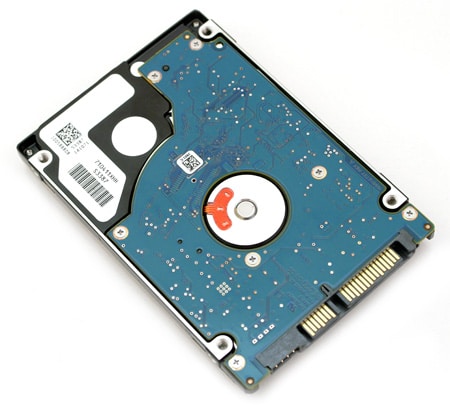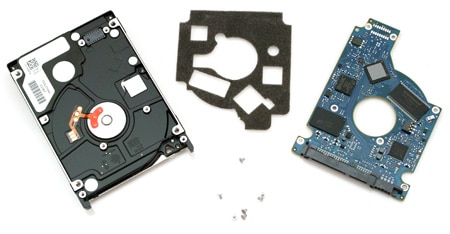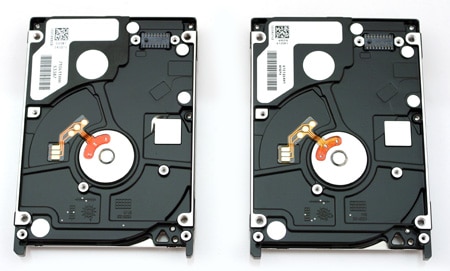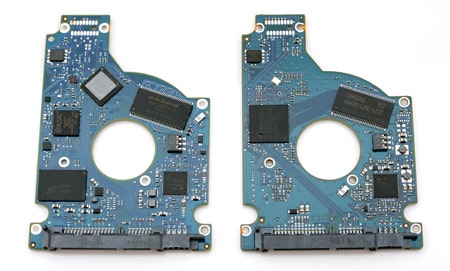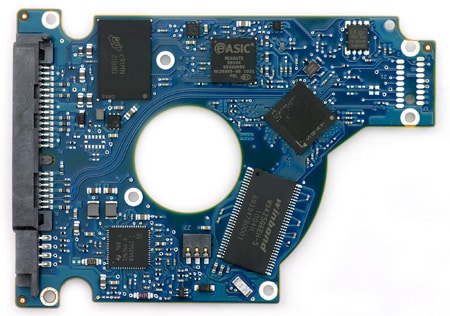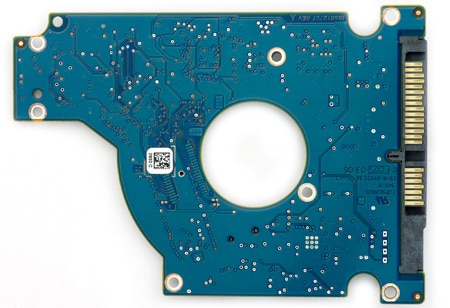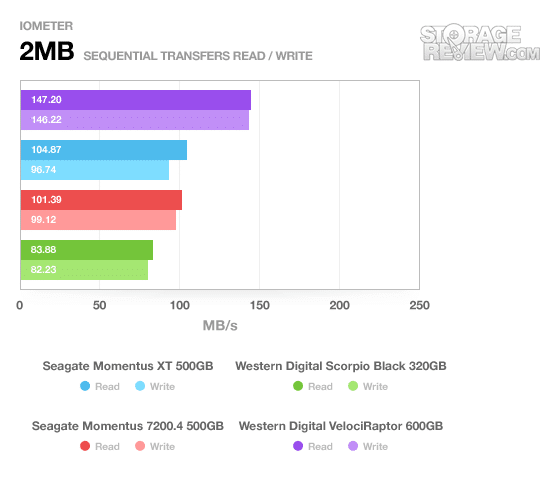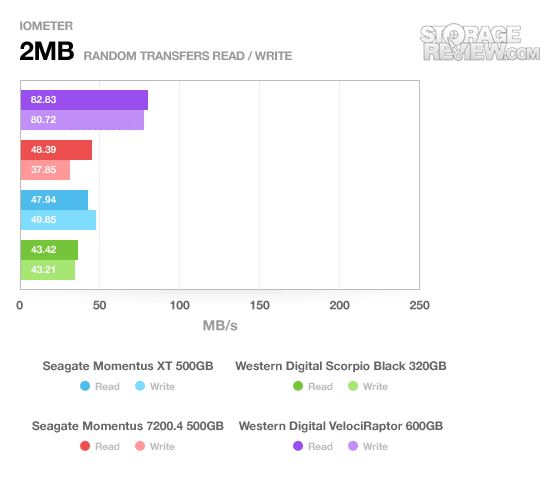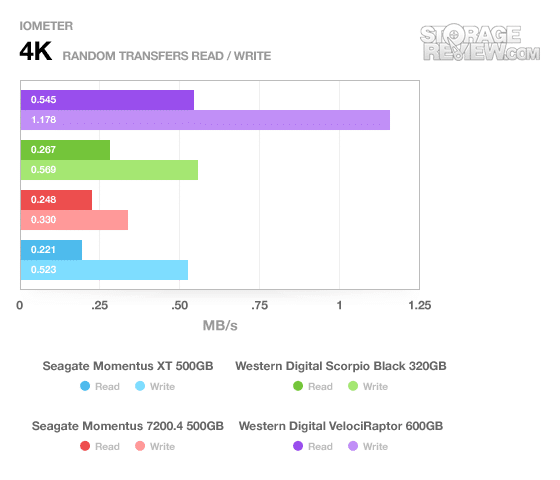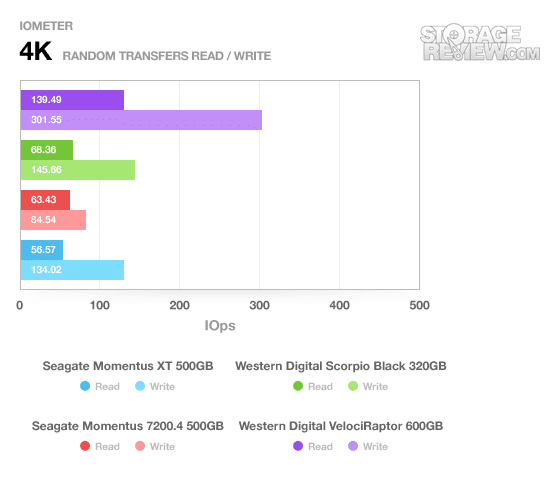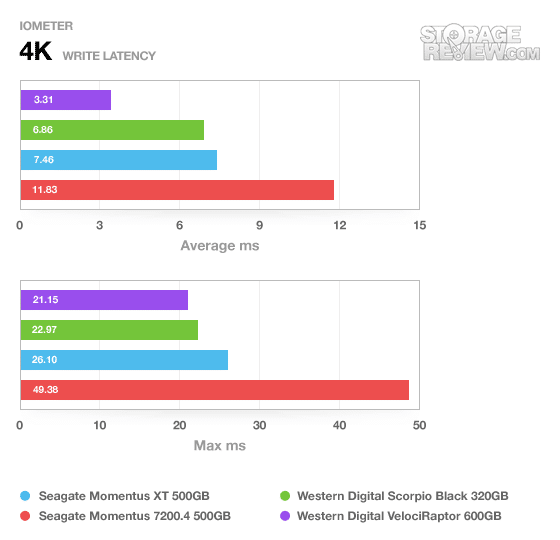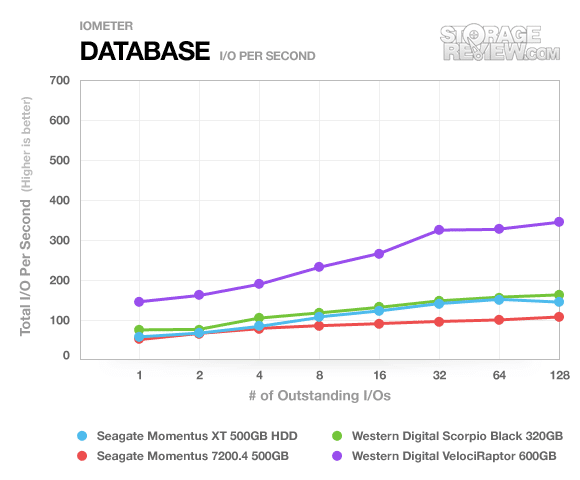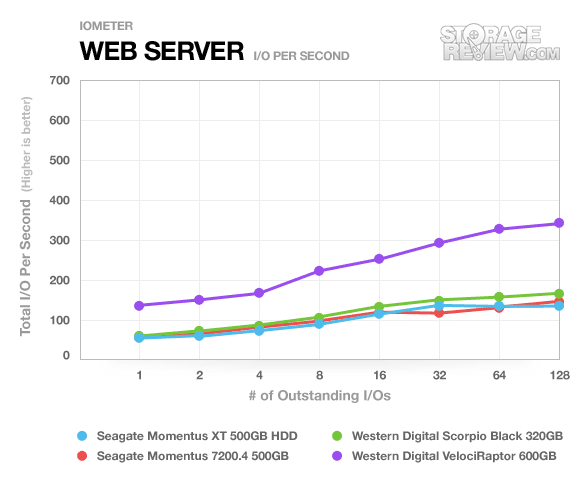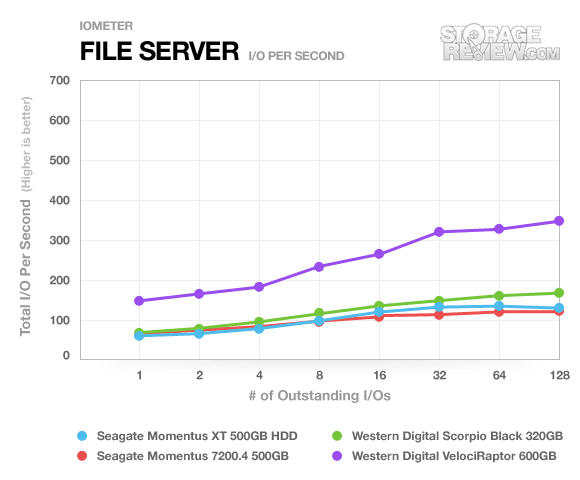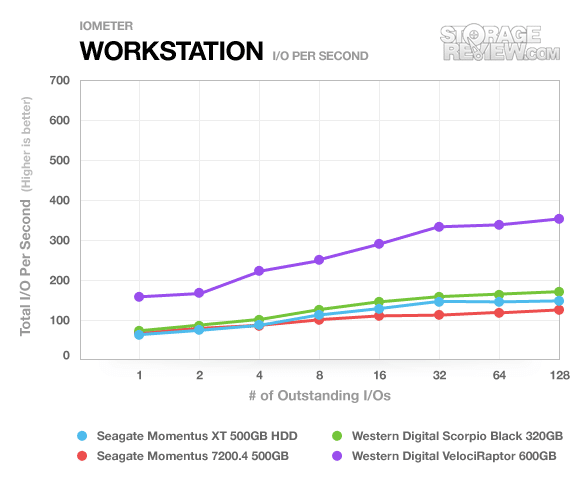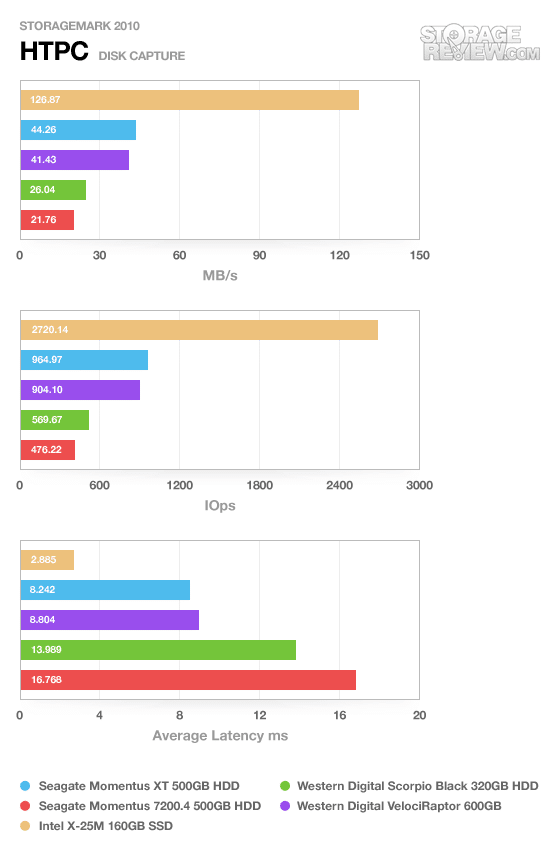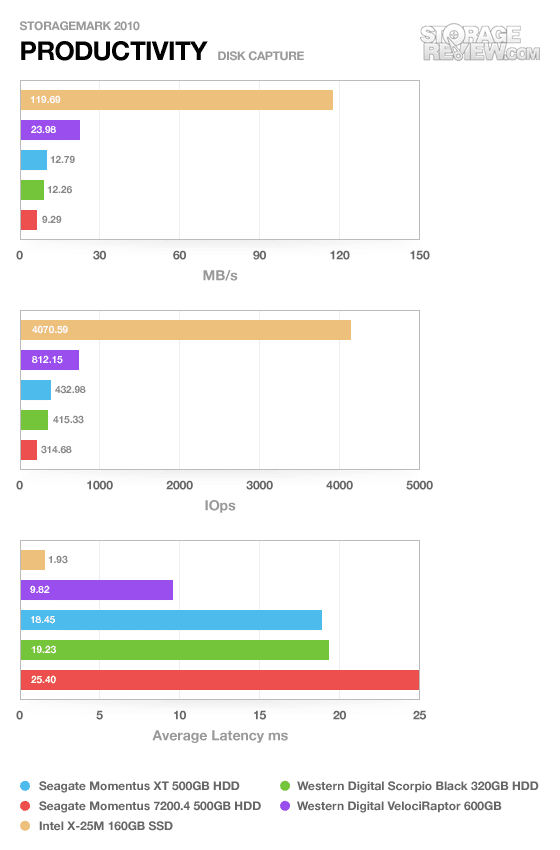
Hard drive manufacturers have seen the writing on the wall; embrace flash storage or suffer the consequences. Seagate is one of the few remaining hard drive manufacturers who haven’t released a line of consumer SSDs. Today though, they have come out with a cross between flash and magnetic storage known as a solid state hybrid drive (SSHD). The hybrid hard drive concept takes a standard spindle hard drive and adds flash and pattern recognizing software to boost drive performance with repetitive tasks. But will 4GB of flash memory sitting on top of a 7200RPM drive offer a big performance gain? Read the full Seagate Momentus XT review to find out.
Update – Seagate Momentus XT 750GB Review Posted
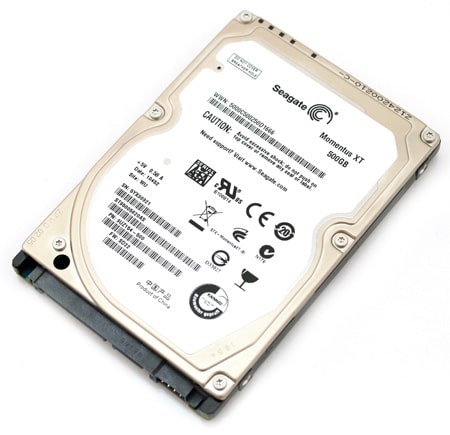
- Interface: SATA 3Gb/s with NCQ
- 2.5" 9mm body
- 4GB SLC Flash
- Cache: 32MB
- Capacity: 500GB
- >600,000 Load/Unload Cycles
- Spindle Speed: 7200 RPM
- Unrecoverable read errors: 1 in 10^14
- Average idle power: 0.8W
- Average seek power: 1.55W
- Acoustics (Idle Volume): 2.3 bels
- Acoustics (Seek Volume): 2.5 bels
- Operating Shock 350G, 1000G Non-Operating
The Seagate Momentus XT HDD/SSD hybrid drive doesn’t really look that much different than a normal hard drive. In fact, Seagate uses the same internals on the new XT that were used in the previous 7200.4. The drive has the standard Seagate drive appearance with a simple all-white label on top of a minimalistic silver cover and black metal body. When we flip it over it still keeps the same look, hiding its hybrid secrets on the inner-facing side of the circuit board. To the naked eye nothing about this drive indicates that it is unlike any other notebook drive on the market.
Build quality is good for a consumer notebook drive. Seagate rates the operating shock at 350G, meaning this drive can survive a pretty good impact like what you might experience if you drop your notebook. The PCB (printed circuit board) has all soldered components facing the drive body to shed heat and protect components from getting hit accidentally.
Disassembly
Taking the drive apart was easy after removing countless precision Phillips head screws. With the circuit board removed we finally get to see what makes this drive so special. This drive uses two controllers, one for the flash memory segment and another for the standard hard drive operations.
With the board removed on the XT and 7200.4 we also get a closer look to see the drives differences and similarities. Both drives with the circuit boards removed are identical down to the machining of the drive surface. Looking at the circuit board we can also see that both drives use the same motor driver. That is where the similarities end though.
The Momentus XT (left) has a 4GB Micron SLC NAND module packed closely to an eASIC controller for the caching part of the drive. The standard platter interface is managed by a Seagate controller which is partially obscured from a thermal pad. Finishing off the design is a larger 32MB Winbond DDR RAM cache module, up from 16MB seen in the 7200.4.
It’s impressive to think Seagate was able to convert an off-the-shelf hard drive into a hybrid HDD/SDD with just a new circuit board and software.
Benchmarks
The performance benchmarks outlined in this review can be categorized into two sections. The first is the standard IOMeter and CrystalDiskMark section which uses randomly generated data/file sequences and the second being repeatable traces. Normally most drives interact with both sets of benchmarks in the same manner, but the Seagate Momentus XT is different. In our IOMeter and CrystalDiskMark tests you will only see raw performance, which normally might translate into real world scenarios. Since the Momentus XT actively caches repeating data patterns, its full performance won’t be seen in the first half of our tests.
In our first test we see the look at the IOMeter 2MB sequential file transfer performance of the Momentus XT. Compared to the 7200.4 it only has a lead of about 3MB/s in read speed but it has a 3MB/s drop in write speed. We are including the Velociraptor in these benchmarks since Seagate made claims directly comparing the performance of the Momentus XT to 10,000RPM drives.
In our IOMeter 2MB random transfer test we see the Momentus XT slips slightly on read speed compared to the 7200.4 but has a significant gain in write speed.
Moving to smaller random transfers in IOMeter we now look at the Momentus XT’s 4K transfer performance relates to the 7200.4 and Scorpio Black (as well as the Velociraptor). The XT’s low random read speed puts it at the bottom of our list, but its write performance is still much better than the older 7200.4.
Write latency of the Momentus XT has greatly improved from the 7200.4, with speeds being improved 37%. With this increase it still falls behind the latency of the Western Digital Scorpio Black and well under the Velociraptor. Max latency was also cut in half compared to the 7200.4, dropping from 49ms to 26ms.
IOMeter server profile tests with the Momentus XT showed only minimal gains compared to the 7200.4, and it still came up short against the Scorpio Black.
The area the Seagate Momentus XT really shone was during our real-world trace playback tests. Since each test includes normal system activity that has some repeating patterns, this lets the SSD module inside the XT actually do what it was designed to do.
Most synthetic benchmarks work with such random data that it defeats or greatly limits any internal caching algorithms used by Seagate. Traces on the other hand play back the exact LBA transfers recorded on a real system, in greater than real-time speed, allowing the drive to actively cache frequently accessed data.
For the average reader looking at our reviews it might be hard to translate high transfer speeds or random 4K performance into real-world performance. In some cases we have seen drives perform exceptionally well in transfer speeds but plummet when it came to our real-world test. With our custom StorageMark 2010 traces we hope that no matter what, any reader can see how drives stack up against each other in everyday situations.
The first real-life test is our HTPC scenario. In this test we include: playing one 720P HD movie in Media Player Classic, one 480P SD movie playing in VLC, three movies downloading simultaneously through iTunes, and one 1080i HDTV stream being recorded through Windows Media Center over a 15 minute period. Higher IOps and MB/s rates with lower latency times are preferred.
In this trace we recorded 2,986MB being written to the drive and 1,924MB being read. As you can see, much of this data was able to be captured in the XT’s onboard 4GB of SLC memory and played back at a very high speed. In this benchmark the Momentus XT lived up to its claim of performing higher than a 10,000RPM hard drive (the Velociraptor). One note, the first benchmark result, before the data was fully cached, was omitted from the final result averaging. The first result gave a score of 728 I/Os, 33MB/s, and 10.95ms average latency. This score was still well above any of the previous notebook drives, showing some caching midway through the test.
Our second real-life test covers disk activity in a productivity scenario. For all intents and purposes this test shows drive performance under normal daily activity for most users. This test includes: a three hour period operating in an office productivity environment with 32-bit Vista running Outlook 2007 connected to an Exchange server, web browsing using Chrome and IE8, editing files within Office 2007, viewing PDFs in Adobe Reader, and an hour of local music playback with two hours of additional online music via Pandora.
In this trace we recorded 4,830MB being written to the drive and 2,758MB being read. As the scoring shows this, in this trace the Momentus XT wasn’t able to surpass the Velociraptor in overall speed, but it still managed to get above the Scorpio Black, and well above the 7200.4.
Since this trace is designed to capture normal performance over a longer period of time most of the caching had to take place on the fly, where it wasn’t able to record the entire trace in its 4GB of SLC storage. While running this trace we didn’t record as big of a jump in performance after the first run. Initial performance of the drive was recorded at 413 I/Os, 12.23MB/s, and 19.34ms average latency.
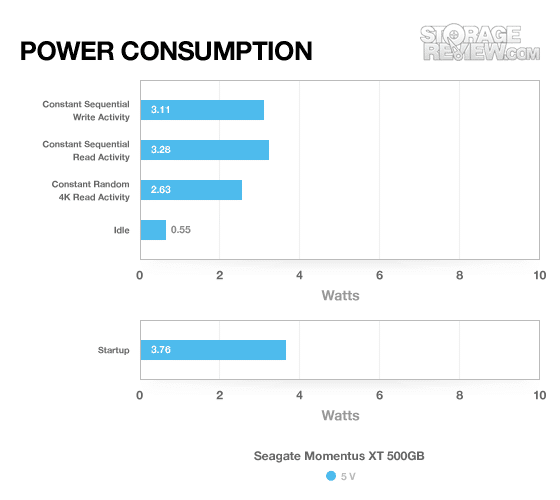
- Hybrid SSD/HDD technology can beat the Velociraptor in certain circumstances
- 500GB for $155
- Better power consumption than older 7200.4
- Won’t win any endurance speed tests
Bottom Line
An SSD doesn’t make sense for everyone, a drive that costs more than the notebook it’s in isn’t practical for most users. The Seagate Momentus XT manages to crank out more performance than any other notebook hard drive on the market, while keeping prices reasonable and capacities high. If you’re looking for more speed in your regular computing activities, there’s no faster hard drive on the market.
Update 3/21/2011 – Seagate Momentus XT SD24 Firmware Update
Update 11/29/11 – Seagate Momentus XT 750GB Review Posted


